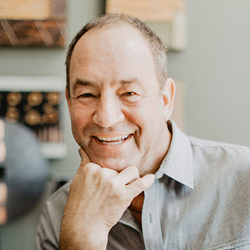Dr. Roy Barsness is the founder of the Relationally Focused Psychodynamic Therapy, an evidence-based treatment approach with strong roots in depth psychology, embodied theology, dialogical philosophy, and neuroscience. He has also developed a Post-Graduate Certificate through The Seattle School where clinicians are able to deepen their understanding and application of relational psychotherapy over a two-year training period.
Here, Dr. Barsness takes a deep-dive into the origins and elements of Relationally Focused Psychodynamic Therapy, its core foundations, its connection to interpersonal neurobiology, and the specific practices of relationally focused therapists.
Relationally Focused Psychodynamic Therapy (RFPT) is a method of treatment grounded in depth psychology (particularly contemporary relational psychoanalysis), interpersonal neurobiology, the dialogical philosophy of Martin Buber, and the sacredness of the person and of the therapeutic act.
RFPT is also an evidenced-based psychotherapy modality focused on transformational change through relationship. We hold to an understanding that we are conceived in relationship, formed in relationship, harmed in relationship, and transformed through relationship. The treatment method is designed to deepen a psychotherapist’s capacity to work directly within the therapeutic relationship as the primary means of change and to develop theoretical and practical skills in the delivery of a relationally-focused treatment.
Origins of Relationally-Focused Psychodynamic Therapy
Relationally Focused Psychodynamic Therapy is as much a meta-theory or method as it is a model, evolving from a wide range of psychoanalytic ideas and theories while offering structure and flexibility in practice.
Relational Psychoanalysis is a movement that began in the 1980s. At that time, a group of psychoanalysts from the NYU post-doctoral program in Psychotherapy and Psychoanalysis 1 launched what they termed a “radical alternative” to the one-person drive theory posited by earlier theoreticians (Freud, Klein, Winnicott, Kernberg, Kohut) to a two-person psychology that emphasized the dyadic, dynamic flow of the therapeutic relationship.
With the understanding that we are shaped interpersonally and that psychopathology is characterized by maladaptive, relational configurations, fundamental to relational psychoanalysis is the power of working intersubjectively – that is directly within the experience of the therapist/patient relationship. Relational psychoanalyst’s basic premise is that human beings are born with a primary need of relatedness and that relatedness is necessary for survival. Relatedness is the primary organizer of mental life. RFPT practices are based on relational psychoanalytic theories and on a qualitative research study conducted in 2017 that resulted in seven core disciplines. 2 These seven disciplines are representative of common practices among relational analysts in conducting a psychodynamic treatment.
The Connection Between RFPT and Interpersonal Neurobiology
Working from a relationally psychodynamic perspective is also informed by interpersonal neurobiology research that explores the effect that relationships (including therapeutic) has on the brain and affect regulation. Researcher Alan Schore states that “regulation theory dictates that in ‘heightened’ affective moments, the patient’s unconscious internal working model of attachment, whether secure or insecure, is reactivated in right-lateralized implicitly-procedural memory and re-enacted in the psychotherapeutic relationships.” 3
Disruptions to the continuity, presence, and availability of primary caregivers plays a central role in psychoneuropathogenesis. Thus, interpersonal relations are the building blocks of the mind, determining our attitudes, perceptions, reactions, our feelings, essentially what we might call “our-selves.” Affective states between the right-brains of the patient and the therapist are best described as intersubjectivity. Right brain processes are reciprocally activated within the therapeutic alliance, are most often unconscious and are “felt” before they are thought.
Working from this perspective creates relational conflict/dissonance and it is the working through of the inevitable ruptures, interlocks, and enactments that shifts the chemistry of the brain. Alan Schore says, “Emotions are deepened in intensity and sustained in time when they are intersubjectively shared [occurring] in moments of deep contact.” 4 Strachey’s translation of Freud’s die seele (soul) to mind, removed the essence of Freud’s intent. The translation sucked the “soul” out of psychology, replacing it with an emphasis on the intellect/the mind.
What has been lost is an understanding of the soul as the spirit of life, the energy that animates us toward the other, the fervor in which we approach our lives. Jungian analyst James Hillman 4 describes the soul as that aspect of the human person which makes meaning possible, [deepens] events into experiences, is communicated in love, and has a religious concern. Perhaps Hillmans’ reference to religious concerns is a nod to the steadfast discernment of the soul as the central moral force embedded deep within a person. Though religion has done its own violence to the meaning of the soul, ultimately both psychodynamic therapy and religion have a shared teleology. Psychodynamic therapies, laboring in the realm of the soul, (whether it is acknowledged or not), are always bumping up against the sacred. Both seek meaning, depth, and purpose. Both in their own forms of confession, forgiveness, and reconciliation, seek to transform the barriers blocking a vital life of love and care for oneself and of the other.
Interpersonal neurobiology can now “track” the power of the human connection and the transformation that occurs when two lives intersect with the other. This intersection is transacted ”when people enter dynamic solidarity with one another…and this deep bonding is contained neither in one, nor the other, nor in the sum of both, but becomes present between them…through directness and wholeness, will and grace, and the presence of mutuality.” 5 Jürgen Moltmann, a well-known systematic theologian, refers to this meeting as the “intimate indwelling and complete interpenetration of the persons in one another…and that by their eternal love, the divine person exists so intimately with one another, for one another and in one another that they constitute themselves in their unique, incomparable and complete unity.” 6
Practices of a Relationally Focused Therapist
In these deep moments of psychological contact, we are on the threshold of the sacred. Relational psychoanalysis, current research conducted in interpersonal neurobiology, the sacred texts of religion and the philosophy of Martin Buber, direct the RFPT mind towards the potency of assisting our patients towards health and well-being. Each advances the notion of therapeutic change through the act of authenticity. By paying attention to affective states, unconscious arousals, and replications within the therapeutic encounter, the patient’s internal world is reexperienced and reimagined.
No two therapists work in the same fashion and, given the uniqueness of each relationship and the working through of what happens in that relationship, it must be so. These are universal practices that can serve as a helpful “map” for conducting our practices while acknowledging and appreciating the intuitive, organic nature of our work, including:
- How we position ourselves (therapeutic intent and therapeutic stance)
- How we reflect (deep listening)
- Attending to the there and then/here and now (patterning/linking)
- How we engage (repetition/working through and courageous speech/disciplined spontaneity)
These primary influencers of relationally-focused psychodynamic work are intended to deepen a psychotherapist’s capacity to work directly within the therapeutic dyad, understanding the therapeutic relationship as the primary instrument towards change.
Learn more about the Relationally-Focused Psychodynamic Therapy Post-Graduate Certificate here.
References
- Lew Aron; Neil Altman; Anthony Bass; Jessica Benjamin; Phillip Bromberg; Jody Messler-Davies; Muriel Dimen; Emmanuel Ghent and Adrienne Harris
- Barsness, R. (2018) Core Competencies in Relational Psychoanalysis. London. Routledge; Schore, A. (2018). The right brain and psychoanalysis. In Barsness, R. (Ed.), Core Competencies in Relational Psychoanalysis: A Guide to Practice, Study and Research, (p. 245). London. Routledge.
- Schore, A. (2018). The right brain and psychoanalysis. In Barsness, R. (Ed.), Core Competencies in Relational Psychoanalysis: A Guide to Practice, Study and Research, (p. 245). London. Routledge.
- Hilman, James (1989). In Moore, T. (Ed.), Selected Writings by James Hillman, (p.21). New York, NY, USA.
- Buber, M. (2003). In Kramer, K.P. (Ed.), Martin Buber’s I and Thou: Practicing Living Dialogue, (p.81). Paulist Press
- Moltmann, J. (1993). God in creation, (p.217). Minneapolis, MN: Fortress Press.


